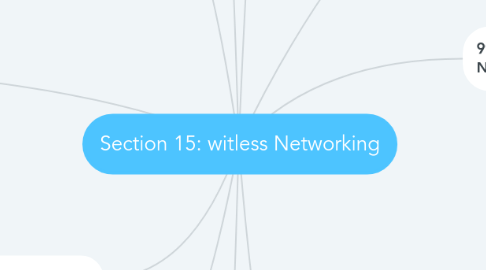Section 15: witless Networking
by Emtenan saad


1. 96. Power Over Ethernet ( PoE )
1.1. * Power over ethernet ( POE) : It is a technology that secures electrical power for devices that are far from the center
1.2. * POE used in WAPs
1.3. * POE injector : Provide additional Power to devices that need it
2. 97. Wireless Security Standards
2.1. * WEP : wired Equivalent Privacy : original encryption that came with wireless devices
2.2. * WPA :WiFi protected access : include TKIp : marketing term has designed because the real standard had not came up yet
2.3. * WAP can be cracked
2.4. * WAP2 is the strongest wireless encryption standard
3. 98. Implementing Wireless Security
3.1. * MAC ACL : access control list based on MAC address
3.2. * Change default username and password
3.3. * Remote management : let you access to configuration screen from a wireless client
3.4. * Client isolation : Single wireless access point and whole people connecting to it
3.5. * If everybody connecting to a single wireless access point they are in Broadcast tonight
4. 100. Retro Threats
4.1. * war driving : is the act of locating and possibly exploiting connections to wireless local area networks while driving around a city or elsewhere
4.2. * War chalking : archalking is the drawing of symbols in public places to advertise an open Wi-Fi network.
5. 101. Wi - Fi Protected Setup ( WPS )
5.1. * ( WPS) is a feature supplied with many routers.
5.2. * WPS : It is designed to make the process of connecting to a secure wireless network from a computer or other device easier.
5.3. * WPS enable one button setup of wireless devices
5.4. * WPS can be easy to hack
6. 102. Wireless Problem Scenarios
6.1. * interference - Use windows utility to check wireless speeds
6.2. PIPA password -Don’t use the wrong WAP password
6.3. * Changes made to wap setting will no longer much client profiles
6.4. * Remove sources of interference or change the WAP's frequency to avoid interference
7. 94. Introduction to Wi - Fi and Wireless Access Points
7.1. * WiFi: short range radio to be used instead of cabling for distribution for local area Networks
7.2. * Wifi based on 802.11 Standard
7.3. * Wireless Access Point(WAP)
7.4. * SSID Service Set Identifier
7.5. Basic Service Set Identifier (BSSID) ( wireless access point +SSID) ( the most simple wireless u make it with WAP )
7.6. * FSSID Extended Service Set Identifier ( multiple WAP all in the same SSID )
7.7. * ISM : Idustrial , Scientific,Medical( ISM)
7.8. * Home Router : (Router + switch + wireless)
8. 95- 802.11 Standards
8.1. * All the different types of 802.11 standard is a ( 802.11 standard + Extensions )
8.2. * 802.11b |1Mbps|2.4 GHz
8.3. * 802.11a | 54 Mbps| 5.0 GHz
8.4. * 802.11g | 54Mbps| 2.4 GHz
8.5. * 802.11n| 74-600Mbps|2.4or5.0 GHz
8.6. * 802.11 ac | 1Gbps| 5.0GHz | support 802.11 b/g/n devices on the 2.4 GHz
9. 99. Threats to Your Wireless Network
9.1. * War driving :is seeking unsecured wireless networks
9.2. * war chalking : means marking their location
9.3. * war driving : War driving, also called access point mapping, is the act of locating and possibly exploiting connections to wireless local area networks while driving around a city or elsewhere
9.4. * War chalking : archalking is the drawing of symbols in public places to advertise an open Wi-Fi network.
9.5. * WIDS : wireless intrusion detection system
9.6. 2 kind of bad wireless access points
9.6.1. 1-Rogue WAP
9.6.2. 2- Evil twin
